Employee goal setting is crucial for reaching broader business goals, but a lot of us struggle to know where to start.
American psychologist Edwin A. Locke first developed the “goal setting” concept as the process of defining key objectives and measurable outcomes that directly (or indirectly) contribute to reaching the overall business goals.
In his research, he explored the link between goals and task performance and found that motivation is crucial for driving teams to make meaningful progress toward their targets.
Still not convinced? Here are some key ways that goal setting helps both businesses and their employees.
Goals for organizations:
- Keep employees and managers focused on shared business goals to reduce wasted efforts and increase impact
- Encourage employees to work together to strengthen team bonds
- Make it easier to track progress, evaluate results, and refine strategies
Goals for employees:
- Increase understanding of how their work contributes to broader organizational success.
- Create a shared sense of direction and motivation among team members.
- Help contribute towards career growth and development opportunities
Stay in the loop
Subscribe to our blog for the latest remote work insights and productivity tips.
Why is employee goal setting important?
Employee goal setting is the biggest indicator of success for any organization. According to Locke and Latham’s Goal Setting theory, 80% of Individuals perform better with specific, challenging goals than those with vague or no goals.
Clearly defined goals can help achieve objectives faster, drive team success, and improve employee performance and morale.
But you may be thinking, what’s the difference between company and individual goals?
There’s a subtle difference, but one’s career goals can often align with reaching successful organizational milestones.
Individual goals could include:
- Career development certifications and learning new skills
- Personal productivity milestones
- Improving work-life balance and reducing burnout
Organizational goals could include:
- Strengthen internal leadership and hire top talents
- Increase employee satisfaction and retention
- Improve internal departmental collaboration
- Hit a new record in the project delivery timeline
Goal setting works best when employee goals align with overarching company objectives. When employees understand how they actively contribute to the company’s success, they are more likely to be motivated and productive.
Here are a few employee goal-setting examples and how to align personal goals with organizational outcomes:
| Organizational Goal | Aligned Individual Goal | How to Align | Benefit |
| Increase product adoption by 20% | Learn advanced product features to support users better | Provide training, set personal KPIs around product expertise | Improves customer support and adoption |
| Expand into a new market | Build skills in cross-cultural communication | Assign regional tasks, offer language or market-specific training | Strengthens global team readiness |
| Improve team collaboration and efficiency | Improve communication and project management skills | Set OKRs related to collaboration; use tools like Slack, Asana | Boosts productivity and cross-team synergy |
What are the challenges when goals are vague or out of alignment?
- Productivity drop-offs due to unclear objectives or siloed teams
- Decreased employee morale due to unrealistic and unmet expectations
- Misalignment due to poorly constructed feedback loops or a complete lack of feedback
The absence of regular productivity monitoring can distract teams from reaching primary goals. You need to track employee performance for the matter metrics to understand what moves the needle.
What are the types of employee goals?
Employee goals come in many forms, and each serves a different purpose. Ultimately, these goals should help connect the dots for broader, company-wide goals.
Performance goals
Employee performance goals are linked to enhancing specific job responsibilities or measurable outcomes (e.g., increasing sales by 10% or improving customer satisfaction scores).
Locke and Latham’s Goal-Setting Theory emphasizes that SMART goals often drive higher outcomes.
Teamwork goals
Teamwork goals are community-driven and strengthen collaboration and communication (e.g., constructively contributing to cross-functional projects and resolving team conflicts).
Harvard Business Review notes that nurturing a sense of belonging through teamwork can improve performance, especially in remote team environments.
Innovation goals
Innovation goals could include creative thinking, problem-solving, and innovative ideas or processes (e.g., proposing one new feature or process improvement per quarter).
McKinsey reports that companies that foster innovation outperform competitors in growth and profitability.
Productivity goals
Employee productivity goals include better time management, resource allocation, and output improvement (e.g., reducing task turnaround time by 15% and automating repetitive workflows).
According to the Hubstaff AI Productivity Shift Report, teams using AI report 77% faster task completion and a 45% boost in productivity.
Professional development goals
Professional development goals help employees build momentum around personal growth and skill building and support their long-term career advancement (e.g., completing a certification or attending a leadership course).
LinkedIn’s Workplace Learning Report shows 94% of employees would stay longer at a company that invests in career development.
Goal setting frameworks to meet the company objectives
Having a goal-setting framework isn’t just helpful; it’s essential.
Without structure, you wouldn’t know if it’s time to hit the gym or sit down for dinner. The same principle applies in organizational objectives for your business: clear, strategic goals keep your teams focused, increase job satisfaction, and enhance employee morale and productivity.
Implementing goal-setting software is helpful, but you’ll still need to establish a goal-setting framework to be successful. But with so many frameworks out there, choosing the right one for your company can be overwhelming.
To help you get started, here are the key types of employee goals you need to understand:
OKRs
Objectives and Key Results (OKR) refers to objectives and key results, a strategic method organizations use to set ambitious, challenging goals with measurable outcomes. OKRs are a great way to engage teams working towards a common goal and measure outcomes.
This method can support employee performance reviews and take employee productivity measurement to a new strategic level.
For example, our marketing team at Hubstaff uses OKRs to align employee and team goals with broader organizational performance. They provide measurable, actionable targets that drive daily productivity and long-term success.
Sample OKR Table:

SMART Goals
SMART goals are Specific, Measurable, Attainable, Realistic, and Time-bound. They can also help teams master time management skills and prioritize tasks.
- Specific: Define who is involved, what needs to be done, and why the goal matters
- Measurable: Clearly see how teams track progress, reach outcomes, and find success
- Achievable: Goals should be realistic and attainable expectations
- Relevant: Should align with broader and meaningful business objectives
- Time-bound: Have a clear deadline or timeframe to create urgency and accountability
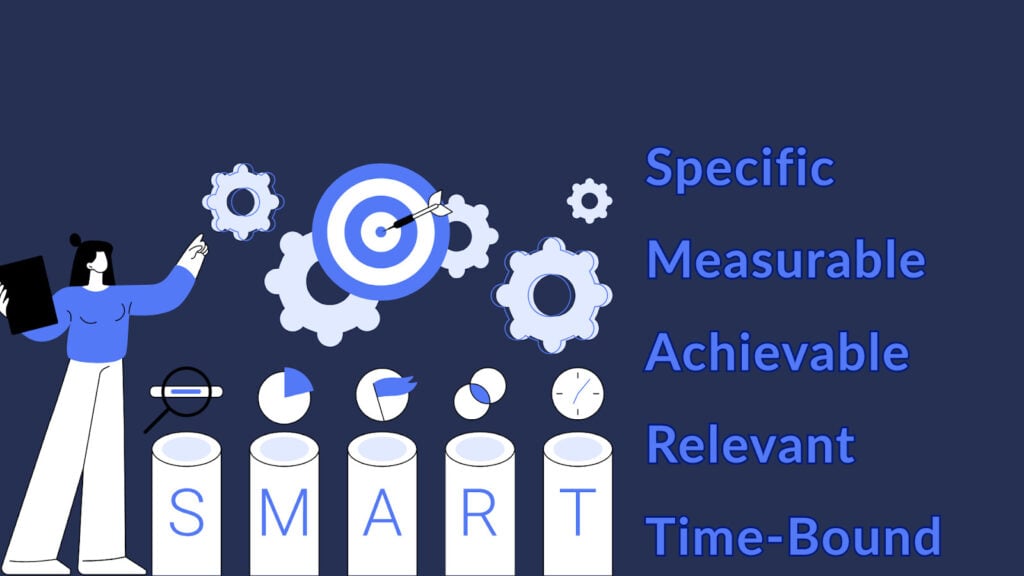
For example, a SMART Goal could increase YouTube subscribers from 6k to 8k within the next quarter, focus on product feature-based tutorials, and replicate the videos with the most views.
Big Hairy Audacious Goals (BHAGs)
BHAGs (Big Hairy Audacious Goals) are bold, long-term objectives planned by the organization to inspire and align everyone toward a shared vision. These goals are designed to push boundaries, focus on the bigger picture, and encourage employees to contribute to a common, ambitious mission.
For instance, planning for a company-wide training program on understanding async work can help shape the broader objectives of a remote team.
Whoop Goals
Wish Outcome Obstacle Plan (Whoop) goals are tied to specific parts of an overall goal associated with cognitive signals. It helps create a motivated workforce.
- Wish – A meaningful desire to achieve something personally significant
- Outcome – The best possible emotional satisfaction stems from fulfilling a wish
- Obstacle – An internal thought or habit that might stop someone from reaching a goal
- Plan – A strategy to overcome internal blockages when they arrive
WOOP is more than goal-setting — it’s a science-backed mental strategy proven to improve self-regulation, individual performance, and follow-through by integrating mental contrasting with implementation intentions.
Goal Pyramid
A pyramid bridges the gap between a long-term and a short-term goal, connecting them and breaking tasks into smaller, more manageable steps. It helps individuals and organizations meet bigger goals more efficiently with clarity and easily measurable progress.
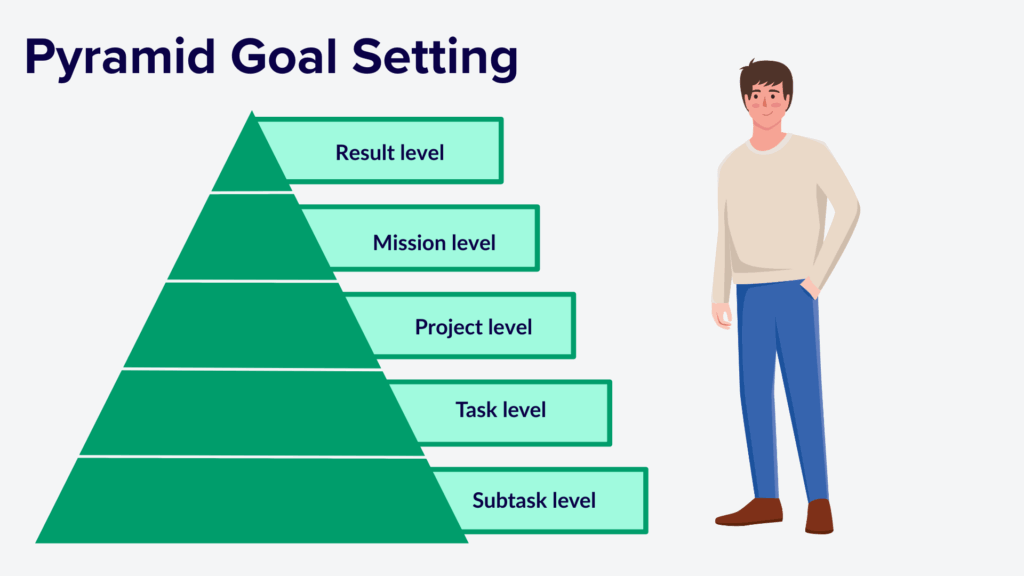
Let’s say the sales team wants to increase annual revenue by 30%, and to achieve this goal they aim to:
- Grow customer base by 20%
- Boost average deal size by 15%
Key actions include:
- Making 40+ outbound contacts weekly
- Scheduling five demos per rep
- Holding weekly sales training and reviews
CLEAR Goals
Clear goals sound exactly like the name — well-defined objectives designed with specific, measurable outcomes in mind. Setting clear goals ensures team alignment, drives accountability, and supports strategic growth.
CLEAR stands for:
- Collaborative: Created with inputs from internal teams
- Limited: Targeting specific outcomes over vague aspirations
- Emotional: Connects to a purpose to drive motivation
- Appreciable: Actionable steps that can be tracked and celebrated
- Refinable: Refining goals as circumstances change without rigidity
For example, a company aiming to improve customer satisfaction might set a clear goal like: “By Q4, increase Net Promoter Score (NPS) by 15% by cutting down customer support response times through the implementation of AI chatbots.
The step-by-step process for setting practical team goals
Employee goal-setting can be effective for any organization, whether a start-up defining business goals or a large business. However, by following a step-by-step approach, companies can help teams and employees reach their own performance goals.
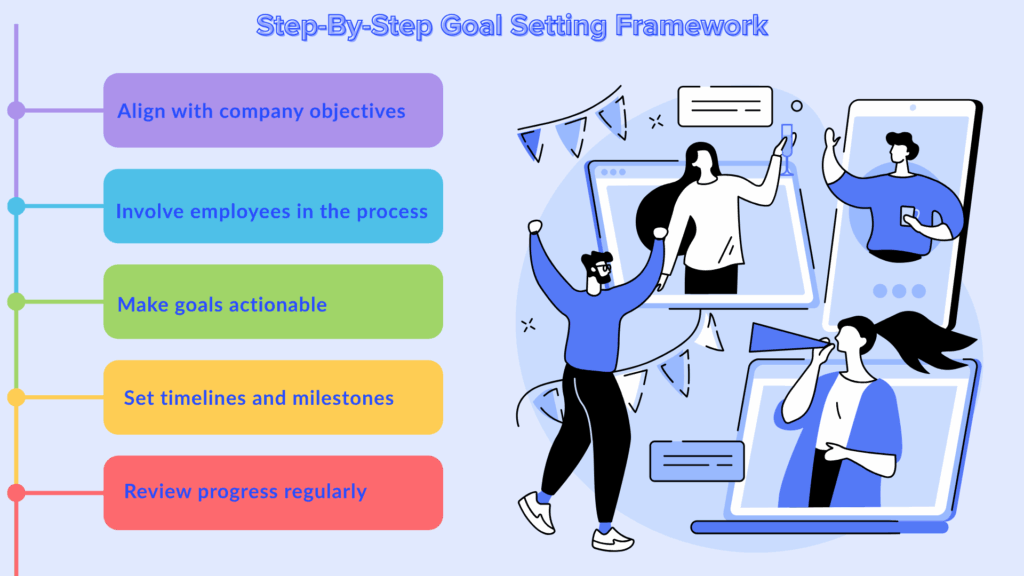
Here are the goal-setting steps that’ll help you get started:
- 1. Align with company objectives. First, ensure that individual goals support your overall business direction. This clear connection helps employees see the broader vision and understand how their work contributes to the company’s success.
- 2. Involve employees in the process. Collaboration leads to connection and a sense of community. Employees’ input into their goals improves the goal-setting process and makes them more likely to take ownership and accountability for said goals.
- 3. Make goals actionable and trackable. Define each goal using clear, measurable criteria. A structure will make progress easier to track and eliminate confusion about what success looks like.
- 4. Set timelines and milestones. Break down goals into smaller steps with deadlines. Milestones help maintain momentum and give opportunities to celebrate progress.
- 5. Review progress regularly. Regular check-ins help address roadblocks early and ensure alignment. These regular performance reviews create a feedback loop that fosters continuous improvement.
Best practices and tips to create well-defined employee goals
When done right, goal setting can bring the best out of a project. But you need the right tools and strategy to reach the desired outcome. These employee goal-setting best practices and tips will set your teams up for success.
Keep communication open
When you nurture transparency and open communication with teams, they work better. Productivity tracking gives managers clear visibility into how teams spend time and provides context for meaningful check-ins. You can easily spot where team members may need support and address roadblocks early, increasing trust and accountability.
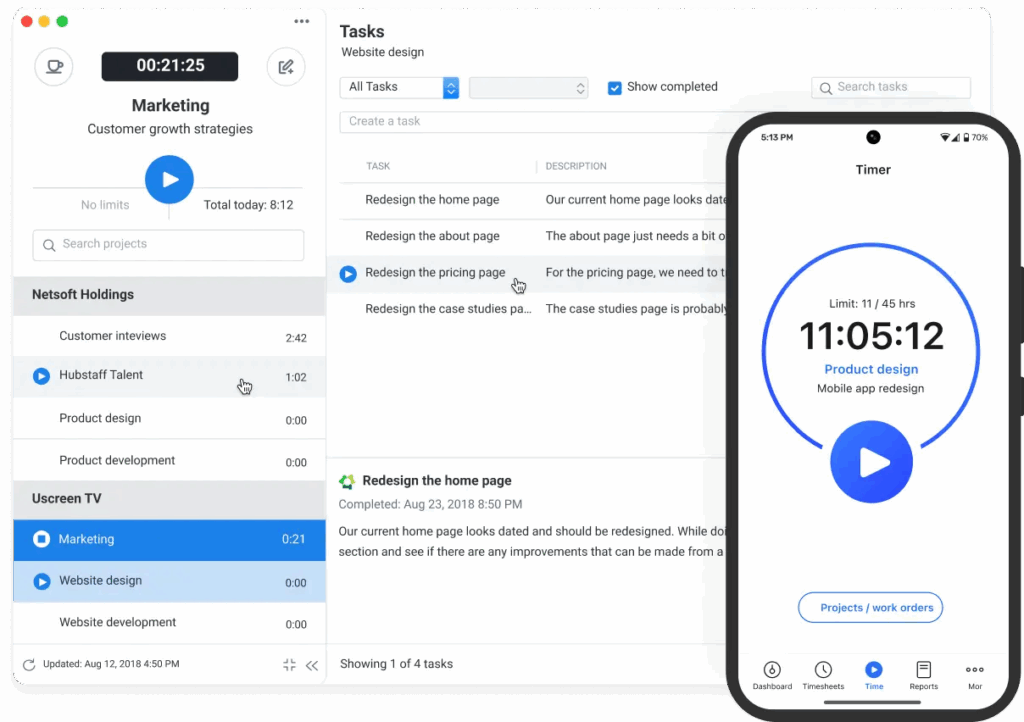
Use technology to streamline the process
Employee time tracking software like Hubstaff isn’t just a time-tracking tool; it’s a full time tracking platform with productivity capabilities — especially when you pair the Insights add-on.
Managers can use Hubstaff to create tasks, track time to them, and visualize progress with customizable, real-time dashboards. You can also pull detailed time reports. This makes it easy to stay on top of milestones without micromanaging.
Celebrate achievements
Easily differentiate between productivity and efficiency and celebrate high performers. With Hubstaff’s 20+ detailed reports, you can quickly spot completed tasks, key project milestones, and well-managed time.
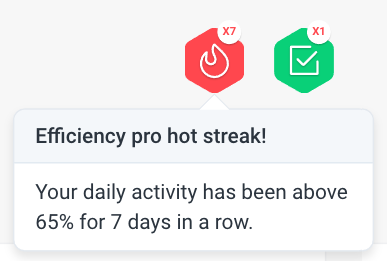
Achievement badges help you identify and celebrate employees for activity hot streaks, task completions, and hours worked.
Be flexible when needed
Business goals shift, and so do tasks and priorities. This requires a robust project management tool to keep up. The Tasks add-on is perfect for:
- Tracking time to tasks and projects. Track time spent on tasks and projects to see hours worked, project spend, and more real-time details for better budgeting.
- Visualizing workflows. Seamlessly shift between Sprint, Timeline, or Kanban views to visualize in ways that make you more productive.
- Setting employee goals. Use the automated Stand-up feature to check in with employees asynchronously. Set goals, gauge employee morale, and address blockers with fully customizable questions.
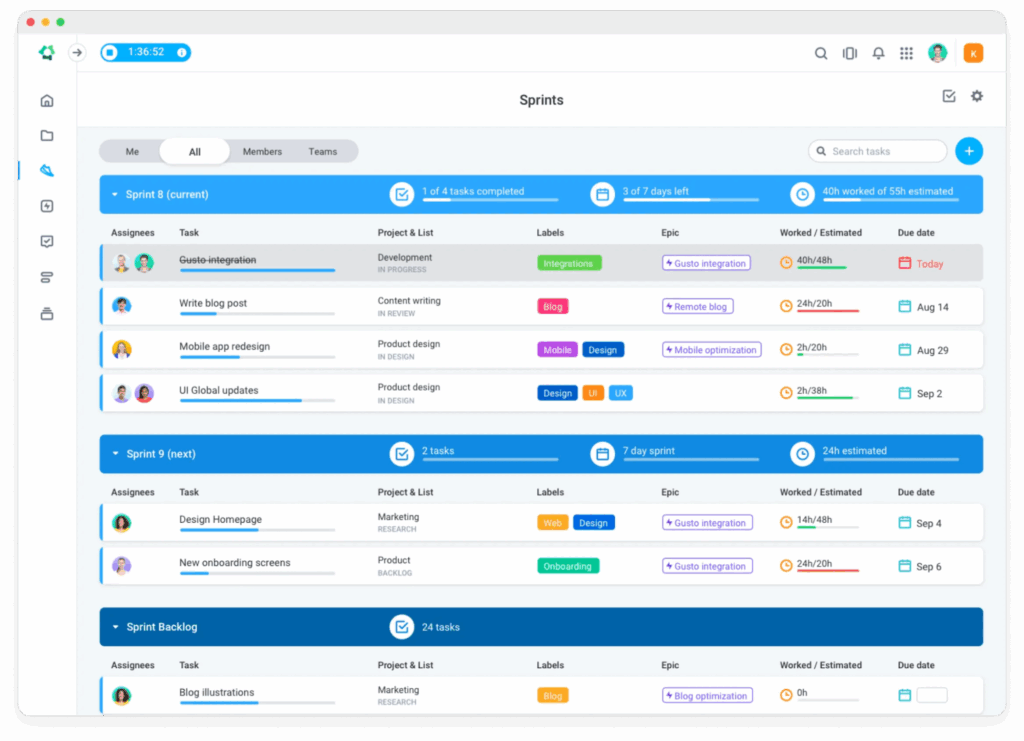
With everything centralized, adapting to change becomes effortless, and your workflow stays smooth and flexible.
Avoid unrealistic goals
Data is your best defense against setting the bar too high. Hubstaff provides granular performance data to set goals based on actual capacity, not guesswork.
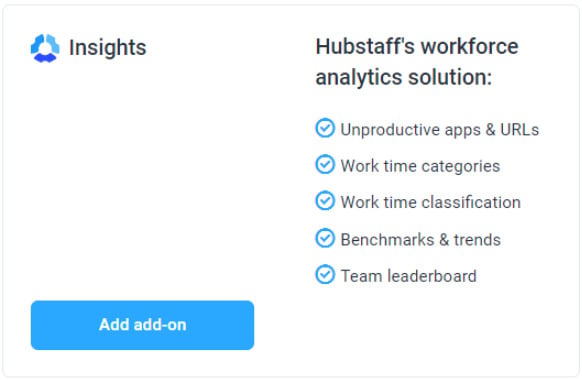
Through detailed reports, uncover employee productivity metrics and Key Performance Indicators (KPIs) that can help, including:
- Task completion rate
- Team utilization
- Focused work sessions
- Results-driven work
Learning from the data, you can set attainable goals and get better outcomes.
FAQs
1. What are the benefits of employee goal setting?
Goal setting gives employees structure, direction, and purpose in daily tasks. It motivates teams by connecting their efforts to meaningful outcomes and drives higher performance.
Benefits include:
- Increased motivation and engagement
- Greater accountability and clarity
- Improved performance management (with tools like Hubstaff)
- Better alignment with team and company priorities
- Support for career development
2. How often should goals be reviewed?
Goals should be reviewed monthly or quarterly, depending on their scope and complexity. Frequent reviews keep everyone aligned and Agile enough to adapt to changes.
With Hubstaff, you can:
- Monitor progress in real-time via dashboards
- Use reports to support regular review meetings
- Quickly identify bottlenecks or success areas
3. What’s the difference between OKRs and SMART goals?
OKRs (Objectives and Key Results) are ambitious, measurable goals that drive team alignment. SMART goals are practical and actionable, focusing on accomplishing specific outcomes within a defined time frame.
Key distinctions:
- OKRs push for growth and innovation
- SMART goals guide short-term execution
- Use Hubstaff to track both project boards and time reports
4. How do you align individual goals with company objectives?
The first step in connecting individual goals to company objectives is breaking down company-wide OKRs into department—and individual-level goals. Ensure employees understand how their tasks contribute to reaching a broader outcome. For instance, there was a 30% revenue increase from last quarter.
Tips for alignment:
- Use Hubstaff Tasks to map goal hierarchies
- Show impact with time tracking and project data
- Reinforce connections in regular 1:1s and team meetings
- Promote ownership with transparent progress tracking
Most popular
Top Employee Monitoring Software for Mac: 2025 Guide
Hey, Mac enthusiasts! Are you feeling a little lost in the complex world of employee monitoring software —especially when lookin...
6 Signs Your Employees Can Tell They’re Being Monitored at Work
Noticing unfamiliar software, restricted access, or slower internet? These might be signs you are being monitored at work. I...
The Complete Guide to User Activity Monitoring: Tools, Benefits, and Ethics
Have you ever noticed how the conversation around monitoring tends to swing between “track everything” and “trust everyone b...
How to Be a Great Remote Manager: Top Strategies and Tips
Steve Jobs once said, “Innovation distinguishes between a leader and a follower.” When you’re learning how to be a great rem...




